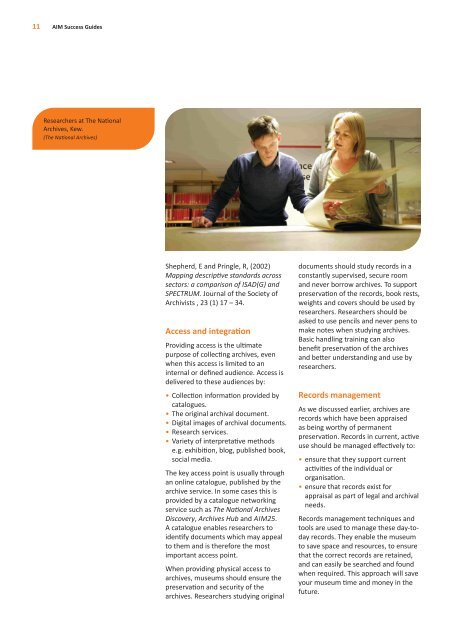Success Guides Successfully Managing Archives in Museums
9bf30cc0-6cd8-11e5-a9ea-901b0e0dc93a
9bf30cc0-6cd8-11e5-a9ea-901b0e0dc93a
Create successful ePaper yourself
Turn your PDF publications into a flip-book with our unique Google optimized e-Paper software.
11 AIM <strong>Success</strong> <strong>Guides</strong><br />
Researchers at The National<br />
<strong>Archives</strong>, Kew.<br />
(The National <strong>Archives</strong>)<br />
Shepherd, E and Pr<strong>in</strong>gle, R, (2002)<br />
Mapp<strong>in</strong>g descriptive standards across<br />
sectors: a comparison of ISAD(G) and<br />
SPECTRUM. Journal of the Society of<br />
Archivists , 23 (1) 17 – 34.<br />
Access and <strong>in</strong>tegration<br />
Provid<strong>in</strong>g access is the ultimate<br />
purpose of collect<strong>in</strong>g archives, even<br />
when this access is limited to an<br />
<strong>in</strong>ternal or def<strong>in</strong>ed audience. Access is<br />
delivered to these audiences by:<br />
• Collection <strong>in</strong>formation provided by<br />
catalogues.<br />
• The orig<strong>in</strong>al archival document.<br />
• Digital images of archival documents.<br />
• Research services.<br />
• Variety of <strong>in</strong>terpretative methods<br />
e.g. exhibition, blog, published book,<br />
social media.<br />
The key access po<strong>in</strong>t is usually through<br />
an onl<strong>in</strong>e catalogue, published by the<br />
archive service. In some cases this is<br />
provided by a catalogue network<strong>in</strong>g<br />
service such as The National <strong>Archives</strong><br />
Discovery, <strong>Archives</strong> Hub and AIM25.<br />
A catalogue enables researchers to<br />
identify documents which may appeal<br />
to them and is therefore the most<br />
important access po<strong>in</strong>t.<br />
When provid<strong>in</strong>g physical access to<br />
archives, museums should ensure the<br />
preservation and security of the<br />
archives. Researchers study<strong>in</strong>g orig<strong>in</strong>al<br />
documents should study records <strong>in</strong> a<br />
constantly supervised, secure room<br />
and never borrow archives. To support<br />
preservation of the records, book rests,<br />
weights and covers should be used by<br />
researchers. Researchers should be<br />
asked to use pencils and never pens to<br />
make notes when study<strong>in</strong>g archives.<br />
Basic handl<strong>in</strong>g tra<strong>in</strong><strong>in</strong>g can also<br />
benefit preservation of the archives<br />
and better understand<strong>in</strong>g and use by<br />
researchers.<br />
Records management<br />
As we discussed earlier, archives are<br />
records which have been appraised<br />
as be<strong>in</strong>g worthy of permanent<br />
preservation. Records <strong>in</strong> current, active<br />
use should be managed effectively to:<br />
• ensure that they support current<br />
activities of the <strong>in</strong>dividual or<br />
organisation.<br />
• ensure that records exist for<br />
appraisal as part of legal and archival<br />
needs.<br />
Records management techniques and<br />
tools are used to manage these day-today<br />
records. They enable the museum<br />
to save space and resources, to ensure<br />
that the correct records are reta<strong>in</strong>ed,<br />
and can easily be searched and found<br />
when required. This approach will save<br />
your museum time and money <strong>in</strong> the<br />
future.


